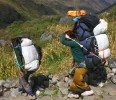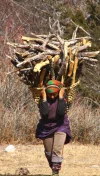Felipe
Veteran Member
Indians in Mexico and Guatemala used mecapalli (Spanish, mecapal, in English, tumpline, see images at http://www.mexicolore.co.uk/aztecs/artefacts/carrying-frame) to carry weights, because in pre-hispanic times there were not beasts of burden. Afterward, donkeys and mules were and are favored (and, currently light diesel pickups), but you can still see peasants resorting to mecapal to carry firewood, corn or pottery for short distances, or in abrupt places where there are not roads. Well, when millions of persons have used a device for many centuries, it should have an experience and a rationale behind it. I decided to try it last weekend, in a three hours walk that included a steep hill. I improvised a mecapal with a standard backpack, with the straps adjusted as needed. The weight was about 5 kg., which is my more or less standard weekend carry (it includes picnic stuff...)
This is my completely un-scientific report about that...
* The right position was not on the forehead, but on the hairline (well, where it used to be...)
* My back was immediately relieved, because the weight is supported by the spine. I discovered that the trick was to align head and spine. I thought that my neck would be stiff and tense, but it was not the case.
* Contrary to what happens with backpack, I tended to stick to one fixed position; it was not comfortable to turn my head around too much.
* When climbing up, I also tended to hunch my back, so I was almost seeing the ground; I did not like it. But when going down, my position was more upright that it would be with a backpack. I discovered that the weight was better distributed, and my (bad) knees were very pleased with the experiment. At the end, I was less tired than usual, although there could be other reasons for that.
* People tended to stare at me as if I were doing a rather strange thing, so I put on my hat...
* Afterward, the improvised strap let a mark, and the skin was a bit reddish, but both disappeared after a while.
I “wikipedied” mecapal/tumpline and discovered that it was also used by Native Americans, and the Canadian Army. But it has almost disappeared, although I found that a Canadian company still sells a backpack with an added tumpline, described as for heavy weights.
I am considering trying this more frequently, with a backpack and “real” weight, with mecapalli maybe not as my standard support system, but as an alternative to ease my back, and when going down a steep hill.
This is my completely un-scientific report about that...
* The right position was not on the forehead, but on the hairline (well, where it used to be...)
* My back was immediately relieved, because the weight is supported by the spine. I discovered that the trick was to align head and spine. I thought that my neck would be stiff and tense, but it was not the case.
* Contrary to what happens with backpack, I tended to stick to one fixed position; it was not comfortable to turn my head around too much.
* When climbing up, I also tended to hunch my back, so I was almost seeing the ground; I did not like it. But when going down, my position was more upright that it would be with a backpack. I discovered that the weight was better distributed, and my (bad) knees were very pleased with the experiment. At the end, I was less tired than usual, although there could be other reasons for that.
* People tended to stare at me as if I were doing a rather strange thing, so I put on my hat...
* Afterward, the improvised strap let a mark, and the skin was a bit reddish, but both disappeared after a while.
I “wikipedied” mecapal/tumpline and discovered that it was also used by Native Americans, and the Canadian Army. But it has almost disappeared, although I found that a Canadian company still sells a backpack with an added tumpline, described as for heavy weights.
I am considering trying this more frequently, with a backpack and “real” weight, with mecapalli maybe not as my standard support system, but as an alternative to ease my back, and when going down a steep hill.
Last edited:















